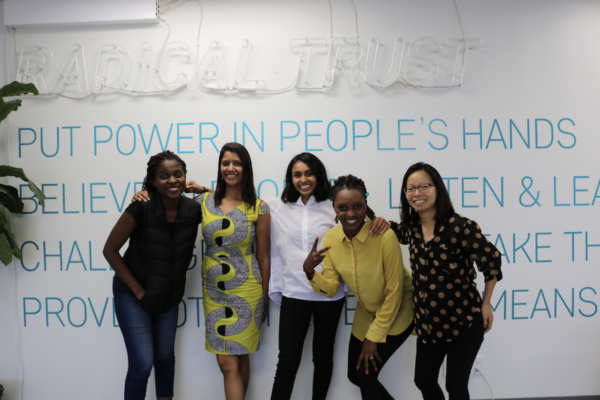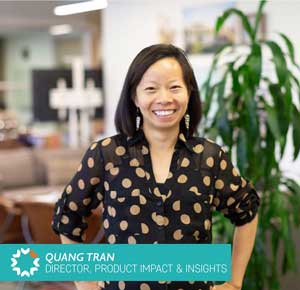Quang Tran, Director of Product Impact & Insights
Following the results of an internally conducted impact study in Kenya, Tala launched a new in-house research division, Product Impact & Insights (PII). As the team continues to grow, Quang Tran, Director of PII and Tala’s former product team lead, explains where the idea came from, why it matters, and how PII is working to keep customers at the center of everything Tala does.
The importance of measuring (and defining) impact
At Tala, our passion isn’t just building a product, it’s about solving a problem for the globally underserved. In order to better understand the difference we make in our customer’s lives, and identify the areas where we need to grow, we conducted a study last year on Tala’s impact in Kenya — our longest-standing market. Now, as our team continues to grow, we want to share what we found, why it matters, and how it’s helping us design life changing products for the financially underserved.
The study was a joint effort between myself, then a product team lead, and Tala’s data analytics lead, Shannon Yates. At the start, we realized there were no metrics that captured what we wanted to learn about our impact, so we hypothesized and defined them ourselves. Since unlocking financial access, choice and control for billions of underserved people requires both short and long-term results, we chose to assess our impact in two categories: immediate and long-term impact.
Here’s a quick look at what we found:
- Immediate impact is readily measurable. We validated that Tala has been key in helping people smooth their income and expenses to have more stability. Of customers surveyed, nearly 8/10 felt increased relief or happiness about their financial situation after taking a Tala loan, including even after they pay the loan back. Studies have shown that people under stress tend to make poorer financial decisions, so this is an important testament to our impact.
- Many customers leverage Tala to grow financially. Although Tala loans start out small and grow afterwards, our study revealed that many Tala customers can use these loans to grow their income. Some customers start with a small side hustle, while others are already established micro-entrepreneurs. Either way, they take Tala credit to buy stock to sell at a profit, or to weather downturns in their business to maintain momentum. We would love to study these customers more longitudinally to understand how they succeed.
- Almost 90% of all customers had significant unexpected financial expenses. We have to provide more flexibility for our customers. Many of our customers lead unpredictable lives and we see it come through in repayment patterns. For example, we learned that even salaried employees can experience instability due to their employer. As we closed the study, we were left with a desire to investigate the other challenges our customers faced and questions like, ‘How can we help the customer reach stability and plan for the future? How do we get to a place where people feel like they’re in control of their money?’
The team taking off
The biggest positive takeaways from the study — that Tala credit helps customers finance micro-businesses, weather unexpected emergencies, and decrease financial stress — allowed us to better understand our short and long-term value. Beyond that, we unearthed more questions and a desire to dig deeper. Luckily, we have an amazing, growing team to do just that.

In the past year, Tala created the Product Impact & Insights team to work hand-in-hand with the product team to ensure that we build great products that change our users’ lives. That means staying close to our customers so that we build the right thing, build that thing right, and understand the results to improve future iterations. As PII’s team of researchers
continues to grow, we have three specific goals:
- First, conduct strategic research on user problems to identify new opportunities for Tala. Here we do problem discovery to inform ideation. This is an important step that product teams often don’t have the luxury of doing but is critical to human-centered design. If you are solving a problem that doesn’t exist or doesn’t matter much to the user, then it’s very difficult to succeed.
- Second, ensure Tala ships solutions that are effective and intuitive to use. Here, we work with product designers and product managers to ideate and test various concepts, aiming to weed out the bad ideas from good as quickly as possible, and then hone usability in designs.
- And finally, ensure that every Tala team member has shared knowledge of solutions’ impact from the user’s perspective. This helps the team to truly learn with each iteration, getting smarter and improving the flywheel of product development each time.

In the coming years, Tala is excited to create a unique process to bring well-designed products to underserved users in frontier markets. And we want to do it at scale. To succeed, we will blend together the tools of ethnography and empathy (the “why”), with technology to measure what users do at scale (the “what”). It’s not one or the other, you must be fluent in both, and our team is up for the challenge.
Click here to read Tala full impact report in Kenya! Share your thoughts and ideas with us at people@tala.co.
Want to build with Quang, Shannon, and the rest of #TeamTala? We’re hiring! We are user researchers, data scientists, engineers, customer experience designers, marketers, and finance geeks all passionate about extending financial freedom to the billions of underserved people across the globe. We believe in people from every type of background — around the world, and within our company.
Come join our global team at Tala.co/Careers!
